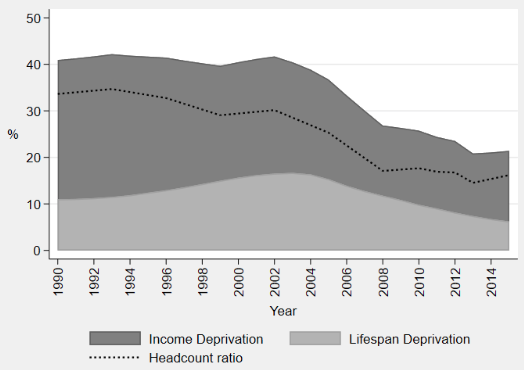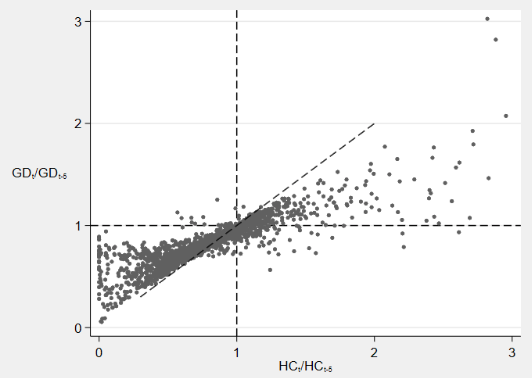
A year prematurely lost is as bad as a year spent in poverty. Aggregating these indices offers a more accurate insight into the progress of nations
In 2015, the United Nations General Assembly adopted the Sustainable Development Goals (SDGs), a collection of 17 global objectives intended to be achieved by 2030. The first of these goals, “No poverty”, is formulated as “ending poverty in all its forms everywhere”. This objective recognises explicitly the multidimensional nature of deprivation.
However, mainstream deprivation indices typically focus on various dimensions of the alive population’s deprivation – such as income, education or health – while not capturing premature mortality, or they focus exclusively on the income dimension of deprivation.
Consider, for example, the evolution of Botswana at the end of the last century. In 1990, life expectancy in Botswana was 63.6 years, and 33.6% of its population was considered as extremely poor. By 2000, life expectancy had fallen to 45.6 years, while the proportion of extremely poor people had dropped to 29.5%.
Over a decade in Botswana, extreme (income) poverty decreased, but people also lived a shorter life. We propose a simple, meaningful, and unambiguous manner to measure the evolution of total deprivation in Botswana between 1990 and 2000: premature mortality and alive deprivation.
Decoding deprivation
Lifespan deprivation
Death per se cannot be a form of deprivation: everyone is mortal. Being deprived means falling short of a minimal standard in a resource. However, an individual dying too young is deprived in the sense that she will not live a number of years considered as minimally acceptable. Under this approach, the resource of interest is the number of years spent alive. Premature death is a severe form of deprivation. We call it ‘lifespan deprivation’.
We show that lifespan deprivation is a particular dimension of deprivation, which requires a specific treatment. Standard composite indices, which treat it as any other dimension, provide inconsistent judgements. We propose a measure of total deprivation in a given year, which consistently aggregate lifespan deprivation with other dimensions of alive poverty.
Income deprivation
Our theoretical analysis shows that lifespan deprivation must be measured in time units, i.e. the number of years prematurely lost due to early death. The fundamental reason is that alive poverty in a given year also records time units: the number of persons spending one year in poverty, i.e. the number of person-years spent in poverty.
Once lifespan deprivation and poverty are measured in the same unit, it becomes possible to impose a meaningful lower bound on the relative weight attributed to each dimension. We argue that one year prematurely lost is at least as bad as one year spent in poverty. Under this lower bound, we are able to characterise the evolution of total deprivation when the basic dimensions move in opposite directions and draw conclusions that do not depend on the choice of a particular weight.
The Generated Deprivation Index
One index that we propose is the ‘Generated Deprivation Index’, which aggregates the number of years of deprivation generated in a given year: how many years of life have been lost to poverty in that year (that is, how many people are poor that year) and how many years of life have been lost in that year (how many premature deaths occurred that year and how many years of life lost these premature deaths generated).
We then divide this number of years of deprivation by the relevant population, which is the alive population in that year to which are added the number of years of life lost to premature death.
Our findings
Our empirical analysis makes two points:
- Globally, lifespan deprivation is a non-negligible component of total deprivation.
- At the country level, ignoring lifespan deprivation leads to incorrect predictions of the evolution of total deprivation.
Extreme poverty and premature mortality in the developing world
There were 705 million people living in extreme poverty in the developing world in 2015 (in the 113 low- and middle-income countries we consider in our analysis), i.e. 705 million person-years in poverty. Premature mortality in that same year caused the loss of 402 million person-years (see Table 1). This shows that lifespan deprivation accounts for 36% of total deprivation, which is certainly not a negligible component.
Moreover, this fraction is increasing over time because of the progress being achieved against extreme poverty. Hence, ignoring lifespan deprivation leads to an increasing bias.
Table 1 Decomposition of total deprivation in the developing world in 2015

Now, consider again the evolution of Botswana at the end of the last century (see Figure 1). Extreme poverty decreased by 12% between 1990 and 2001, while total deprivation remained roughly stable (+0.7%). This was due to the large increase in mortality rates that followed the spread of the HIV epidemic.
Figure 1 Total deprivation and poverty (head-count ratio) follow opposing trends in Botswana over 1990 – 2001

Under the assumption that one year prematurely lost is as bad as one year spent in poverty, we cannot conclude that total deprivation has decreased in Botswana. We must conclude that the increased mortality has more than compensated for the reduction in extreme poverty.
How often do these opposite diagnostics arise in the last 25 years in the 113 countries that we study?
In Figure 2, we plot the ratio of the value of the Generated Deprivation index (GD) in year t relative to its value in t-5 for each country in our sample against that for the head-count ratio (HC). As indicated by the figure, overall, the two measures generally agree. However, the two measures do not always agree, as attested by the large number of points located in the north-west and in the south-east quadrants. These points represent 8.4% of the comparisons made – in these cases, the diagnostic of deprivation based on income contradicts the one based on total deprivation. This means that in 8.4% of the cases, omitting lifespan deprivation leads to a bias so severe that even the sign of the evolution may be wrong.
Figure 2 Deprivation trends in the world: Generated Deprivation index and poverty head-count index five-year evolution at the country level

Accounting for premature mortality in measuring deprivation
Despite major scholars such as Amartya Sen and Angus Deaton arguing that the lifespan is one of the major determinants of wellbeing, most mainstream deprivation indices do not account for premature mortality. The scarcity of theoretical attempts at producing measures combining it with poverty may partially explain this state of affairs. Our study shows that non-biased measures of total deprivation must consistently account for premature mortality. To this end, we propose one measure that is easily interpretable and can be computed based on available data.
As we show, this measure allows a more global and consistent picture of the evolution of total deprivation. In this respect, premature deaths constitute an important aspect of deprivation, the importance of which increases through time thanks to the gradual reduction in income poverty. Moreover, this measure highlights the trade-off between income poverty and premature mortality in a meaningful and understandable way: how many years spent in poverty are worth one year of life? Finding their own answers to this question may help policymakers identify which interventions are most urgent and distribute their efforts and funds between poverty-alleviating policies and health policies.
References
Baland, J M, G Cassan and B Decerf, (2019), “'Too young to die': Deprivation measures combining poverty and premature mortality", CEPR Discussion Paper 14059.



